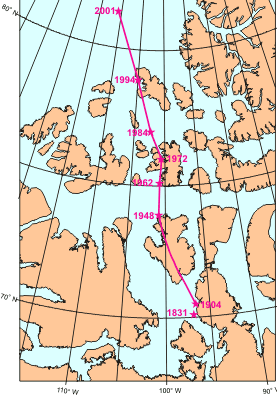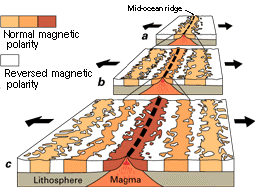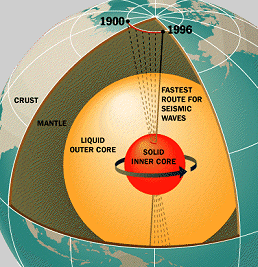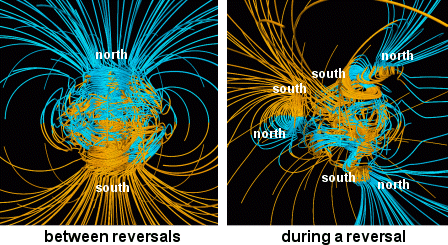

Idioma Espaņol
Every few years, scientist Larry Newitt of the Geological Survey of Canada goes hunting. He grabs his gloves, parka, a fancy compass, hops on a plane and flies out over the Canadian arctic. Not much stirs among the scattered islands and sea ice, but Newitt's prey is there--always moving, shifting, elusive. 
His quarry is Earth's north magnetic pole. At the moment it's located in northern Canada, about 600 km from the nearest town: Resolute Bay, population 300, where a popular T-shirt reads "Resolute Bay isn't the end of the world, but you can see it from here." Newitt stops there for snacks and supplies--and refuge when the weather gets bad. "Which is often," he says. Right: The movement of Earth's north magnetic pole across the Canadian arctic, 1831--2001. Credit: Geological Survey of Canada. [More] Scientists have long known that the magnetic pole moves. James Ross located the pole for the first time in 1831 after an exhausting arctic journey during which his ship got stuck in the ice for four years. No one returned until the next century. In 1904, Roald Amundsen found the pole again and discovered that it had moved--at least 50 km since the days of Ross. The pole kept going during the 20th century, north at an average speed of 10 km per year, lately accelerating "to 40 km per year," says Newitt. At this rate it will exit North America and reach Siberia in a few decades. Keeping track of the north magnetic pole is Newitt's job. "We usually go out and check its location once every few years," he says. "We'll have to make more trips now that it is moving so quickly." Earth's magnetic field is changing in other ways, too: Compass needles in Africa, for instance, are drifting about 1 degree per decade. And globally the magnetic field has weakened 10% since the 19th century. When this was mentioned by researchers at a recent meeting of the American Geophysical Union, many newspapers carried the story. A typical headline: "Is Earth's magnetic field collapsing?" Probably not. As remarkable as these changes sound, "they're mild compared to what Earth's magnetic field has done in the past," says University of California professor Gary Glatzmaier. 
Sometimes the field completely flips. The north and the south poles swap places. Such reversals, recorded in the magnetism of ancient rocks, are unpredictable. They come at irregular intervals averaging about 300,000 years; the last one was 780,000 years ago. Are we overdue for another? No one knows. Above: Magnetic stripes around mid-ocean ridges reveal the history of Earth's magnetic field for millions of years. The study of Earth's past magnetism is called paleomagnetism. Image credit: USGS. [More] According to Glatzmaier, the ongoing 10% decline doesn't mean that a reversal is imminent. "The field is increasing or decreasing all the time," he says. "We know this from studies of the paleomagnetic record." Earth's present-day magnetic field is, in fact, much stronger than normal. The dipole moment, a measure of the intensity of the magnetic field, is now 8 x 1022 amps x m2. That's twice the million-year average of 4 x 1022 amps x m2. To understand what's happening, says Glatzmaier, we have to take a trip ... to the center of the Earth where the magnetic field is produced. At the heart of our planet lies a solid iron ball, about as hot as the surface of the sun. Researchers call it "the inner core." It's really a world within a world. The inner core is 70% as wide as the moon. It spins at its own rate, as much as 0.2o of longitude per year faster than the Earth above it, and it has its own ocean: a very deep layer of liquid iron known as "the outer core." 
Right: a schematic diagram of Earth's interior. The outer core is the source of the geomagnetic field. [Larger image] Earth's magnetic field comes from this ocean of iron, which is an electrically conducting fluid in constant motion. Sitting atop the hot inner core, the liquid outer core seethes and roils like water in a pan on a hot stove. The outer core also has "hurricanes"--whirlpools powered by the Coriolis forces of Earth's rotation. These complex motions generate our planet's magnetism through a process called the dynamo effect. Using the equations of magnetohydrodynamics, a branch of physics dealing with conducting fluids and magnetic fields, Glatzmaier and colleague Paul Roberts have created a supercomputer model of Earth's interior. Their software heats the inner core, stirs the metallic ocean above it, then calculates the resulting magnetic field. They run their code for hundreds of thousands of simulated years and watch what happens. What they see mimics the real Earth: The magnetic field waxes and wanes, poles drift and, occasionally, flip. Change is normal, they've learned. And no wonder. The source of the field, the outer core, is itself seething, swirling, turbulent. "It's chaotic down there," notes Glatzmaier. The changes we detect on our planet's surface are a sign of that inner chaos. They've also learned what happens during a magnetic flip. Reversals take a few thousand years to complete, and during that time--contrary to popular belief--the magnetic field does not vanish. "It just gets more complicated," says Glatzmaier. Magnetic lines of force near Earth's surface become twisted and tangled, and magnetic poles pop up in unaccustomed places. A south magnetic pole might emerge over Africa, for instance, or a north pole over Tahiti. Weird. But it's still a planetary magnetic field, and it still protects us from space radiation and solar storms.
Above: Supercomputer models of Earth's magnetic field. On the left is a normal dipolar magnetic field, typical of the long years between polarity reversals. On the right is the sort of complicated magnetic field Earth has during the upheaval of a reversal. [More] And, as a bonus, Tahiti could be a great place to see the Northern Lights. In such a time, Larry Newitt's job would be different. Instead of shivering in Resolute Bay, he could enjoy the warm South Pacific, hopping from island to island, hunting for magnetic poles while auroras danced overhead. Sometimes, maybe, a little change can be a good thing.
Feature Production Editor: Dr. Tony Phillips Feature Production Credit: Science@NASA Core ConcernsThe hidden reaches of Earth are starting to reveal some of their secretsBy RICHARD MONASTERSKY
Gary A. Glatzmaier gazed
down on the world he had created
and decided it was good. Peering
deep into the bowels of the
planet, he saw vast currents of
molten iron alloy swirling at
temperatures above 5,000
kelvins, nearly as hot as the
surface of the sun. He watched
for 40,000 years as the globe's
magnetic field pulsated like the
beating of a heart. Deeper
still, at the center, he beheld
a spinning orb made of solid
iron almost as large as the
moon. This creation, forged from
numbers and equations, is a
virtual version of Earth's
metallic core. Glatzmaier, a
geophysicist at Los Alamos
(N.M.) National Laboratory,
constructed the extremely
sophisticated computer model to
simulate the magnetic dynamo
that churns away, unseen, far
below Earth's crust. Five years ago, most
geophysicists considered such
representations poor stand-ins
for the real core -- the
scientific equivalent of a
tone-deaf Elvis impersonator. In
the last year, however, these
models have earned newfound
respect by showing striking
similarities to the real thing.
The simulation by Glatzmaier and
his colleague Paul H. Roberts of
the University of California,
Los Angeles scored a major coup
with its prediction that Earth's
solid inner core spins out of
sync with the rest of the planet
-- a feature verified 3 months
ago by seismologists (SN:
7/20/96, p. 36,
Putting a New Spin on Earth's
Core ). Combined with recent
advances in seismology, the
computer models are opening
windows into Earth's hitherto
impenetrable iron heart. This
new access gives scientists hope
that they can finally tackle
what Einstein reputedly called
one of the five greatest
unsolved problems in physics:
the origin of the planet's
magnetic field. Although theorists have
made great strides since
Einstein offered that challenge,
geomagnetists still lack a firm
understanding of how the field
forms and why it changes
direction every few hundred
thousand years or so. "The
mechanisms behind the magnetic
field and behind the reversals
are still really mysterious.
It's fair to say that this is
one of the grand intellectual
challenges -- not just in the
earth sciences, but, I think, in
all of the physical sciences,"
says Raymond Jeanloz, a
geophysicist at the University
of California, Berkeley.
A soft-spoken scientist
most at home among his
equations, Glatzmaier declines
any comparison with the creator
in Genesis. It's interesting to
note, however, that Glatzmaier
began his modeling work with the
sun, only later moving on to
model Earth. Initially, Glatzmaier
simulated the sun's magnetic
field, which arises from the
motion of ionized hydrogen and
helium inside that star. The
branch of physics governing this
realm is called
magnetohydrodynamics, a mouthful
of a term that researchers often
shorten to MHD. After the sun, Glatzmaier
studied Jupiter, the Kuwaiti oil
fires, and Earth's rocky mantle
before finally turning to
Earth's core. The recent model
-- a variation of the one
developed for the sun --
simulates in three dimensions
the currents of iron alloy
flowing within the core. The planet's nucleus is
believed to have formed early in
Earth's 4.5-billion-year
history, when molten iron and
other heavy elements sank deep
into the planet. As this
metallic soup cooled over the
eons, crystals of iron froze at
the center, creating a solid
iron core inside the surrounding
liquid alloy. Over time, this process
built an inner core 2,440
kilometers wide, about one-fifth
the diameter of the planet. The
outer core of liquid alloy spans
2,260 km from top to bottom and
is composed of 90 percent iron
and 10 percent lighter elements,
possibly oxygen and sulfur. The slow cooling of the
core, which continues today, is
critical because it stirs the
iron alloy. Heat escaping from
the top of the outer core chills
the upper layers of the outer
core, causing the material to
sink. At the same time, iron
crystals freeze and adhere to
the surface of the inner core,
leaving behind material richer
in the lighter elements. This
alloy floats to the surface of
the outer core. This movement of metallic
fluids gave birth to Earth's
geomagnetic field, according to
MHD theory. Basic physics
teaches that moving metals can
produce an electric current if
they pass through a preexisting
magnetic field. This principle
underlies most electric
generators, which use heat to
move turbines that carry wires
past magnets. If magnetic fields were
common in the early solar
system, as scientists believe,
then convective flow in the
outer core must have created
electric currents in the fluid
iron. The process turned into a
self-sustaining dynamo, because
electric currents produce their
own magnetic fields. Once the
core started producing a
magnetic field, the continuous
movement of the iron alloy would
have maintained electric
currents in the outer core,
thereby sustaining the
geomagnetic field.
|
|||||||||||||||||
